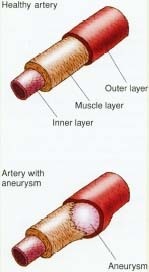Aneurysm
An aneurysm (AN-you-rizm) is an abnormal widening of a blood vessel that may cause massive bleeding, shock, or death if it ruptures (breaks open).
KEYWORDS
for searching the Internet and other reference sources
Cardiovascular system
Cerebrovascular system
Circulatory system
Why Are Aneurysms Called "Silent Killers"?
Aneurysms are sometimes called "silent killers" because they may go undetected for years until they break open. The wall of a section of an artery * , vein * , or other blood vessel may become weak and begin to bulge, like an underinflated balloon whose air is squeezed from the ends to the middle. The bulge may grow slowly for years until one day the blood vessel wall gives way. When this happens, it becomes a medical emergency that may lead to death.
Aneurysms occur most often in the aorta, the large artery that runs from the heart down through the abdomen. More than 15,000 people a year die when an aneurysm in this area breaks. Aneurysms can occur in other parts of the chest and body. When they occur in the brain, they may lead to stroke * .
How Do Aneurysms Happen?
Aneurysms result when the normal structure of blood vessels becomes weak in one area. This can occur when fatty deposits of cholesterol accumulate on the walls of the blood vessels but also may result from infection or from trauma or be congenital * . An increased incidence of aneurysm may be seen with certain conditions, such as syphilis or Marfan syndrome. Many times, however, an aneurysm develops without any known cause.
* artery An artery is a vessel that carries blood from the heart to tissues in the body.
* vein A vein is a vessel that carries blood to the heart. Veins have greater capacity and thinner walls than arteries and contain valves that prevent blood from flowing backward and away from the heart.
* stroke A stroke occurs when a blood vessel bringing oxygen and nutrients to the brain bursts or becomes clogged by a blood clot or other particle. As a result, nerve cells in the affected area of the brain, and in the specific body parts they control, do not function properly.
* congenital means present at birth.
The condition affects many more men than women. It also occurs more often in people who are older than age 55, who are smokers, or who have high blood pressure. People with other family members who have had aneurysms are more likely to develop aneurysms themselves.
There usually are no signs of a growing aneurysm. Sometimes, people feel pain in their abdomen, if that is where the aneurysm is. A large aneurysm in the abdomen may press against the spine and cause back pain. A burst aneurysm in an artery can kill a person quickly. One in the brain can cause symptoms of a stroke, like shock, numbness, paralysis, and vision loss.
How Do Doctors Diagnose and Treat Aneurysms?
Fortunately, many aneurysms can be detected before they burst. Doctors often are able to feel the pulsating sensation of abdominal aneurysms through the skin. Also, aneurysms often cause subtle changes in how the heart sounds, and doctors might notice these changes when listening to the heart. The most reliable methods of checking for aneurysms are x-rays, ultrasound * exams, and other scans that give more detailed images of the body.
Wait and see
If an aneurysm is discovered, sometimes a doctor will adopt a "wait-and-see" strategy, but often this depends on the aneurysm's location, size, and the person's overall health. Small aneurysms might be checked every six months or so to be sure they are not growing. Aneurysms usually grow slowly, especially if the person adopts healthy lifestyle habits, which include not smoking, controlling blood pressure, exercising, reducing weight if necessary, not drinking alcoholic beverages, and eating an appropriate diet.
Surgery
Sometimes surgery is required. One method involves removing the section that is bulging and replacing it with an artificial blood vessel. Newer techniques involve snaking a thin, flexible wire up from an artery in the leg to the aneurysm, where a tube or coils are attached to the artery's walls on either side of the aneurysm.
How Are Aneuryms Prevented?
It is most important to catch aneurysms before they break open. More than 60 percent of people whose aneurysms burst die before they reach the hospital, and a large percentage may die during or after emergency surgery. Regular medical care, surgery, and changing lifestyles allow the vast majority of people with aneurysms to recover.

Monster of a Headache
R.E.M. was rocking their way through Europe during their 1995 "Monster" Tog when drummer Bill Berry got a sudden, terrible headache and could not see. Berry had a brain aneurysm, which wa operated on immediately. The surgery XNas a complete success, and the band was able to finish touring with their excelleiit drummer.
* ultrasound exams or sonograrns use inaudible sound waves that can be projected by special equipment to produce animat or picture of an organ or tissue. This can help doctors to diagno an illness and determine how biest to treat the patient.
Resources
The U.S. National Institute of Neurological Disorders and Stroke posts a
fact sheet about cerebral aneurysm at its website.
http://ninds.nih.gov/healinfo/DISORDER/Aneurysm/aneurysm.htm
American Heart Association, 7272 Greenville Avenue, Dallas, TX 75231.
The American Heart Association posts information about aortic aneurysms
and many other heart conditions at its website.
Telephone 800-242-8721
http://www.amhrt.org
National Stroke Association, 96 Inverness Drive East, Suite I,
Englewood, CO 80112-5112. The National Stroke Association website
contains information about aneurysms and new surgical techniques.
Telephone 800-787-6537
http://www.stroke.org
The Heart and Stroke Foundation of Canada posts a fact sheet about
aneurysm at its website.
http://www.hsf.ca/az/atoz-a.htm
See also
Hemorrhage
Marfan Syndrome
Stroke
Comment about this article, ask questions, or add new information about this topic: